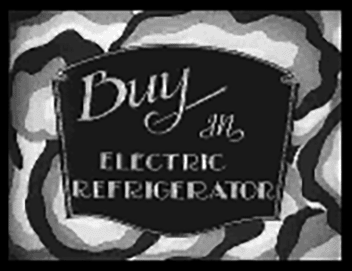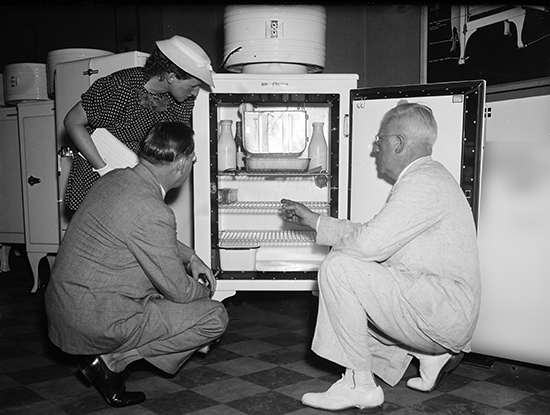First, Electricity
Getting electricity into every American home was the monumental goal for the electric companies [Gov PDF] from circa 1900 to the 1930s, when the last homes in rural areas became electrified. Having an electric-run kitchen with manufactured foods required educating the homemaker. Efforts from the government such the Smith-Lever Act [wiki] of 1914 and Smith-Hughes Act [wiki] in 1917 existed to help educate teachers to the new ways of managing house and garden with the new inventions. Working in tandem, electric utility companies [wiki video] often co-sponsored electric refrigerator cooking schools, films, and other marketing efforts–such as Ohio Edison Electric sponsoring a magician in 1929 who handed out cards at his magic shows guiding the audiences to the Frigidaire salesman in the lobby!

There were downsides to modernizing, which of course new converts weren’t aware of yet, such as a more sedentary lifestyle, an unintelligible reliance on modern updates that leave people clueless as to how to survive without them, and the establishment of November 15th’s Clean Out Your Refrigerator Day. But most new consumers were understandably gigaamps happy with the new invention of electric refrigeration.
But now, my family truly understands the value of a humble refrigerator and how it impacts our daily lives. This revelation came to us when our electric refrigerator broke down during a scorching August heatwave in Florida. Usually, a repair person would swiftly fix the issue, but we had an eco-friendly model that required a specialized technician to work on the compressor to avoid the risk of fire. It took six long days for them to arrive. During this time, we experienced firsthand the challenges of keeping our food chilled with just a simple unelectrified fridge and ice, with towels on the floor until we got the hang of it. Surprisingly, three 10-pound bags of ice per day were sufficient to keep our perishable items safe, although we had no means to freeze anything. We were reminded that back in the early 1900s, people purchased ice blocks every 2-3 days to maintain their iceboxes, and when considering inflation, comparing our costs for the ice, modern-day food safety concerns, and inconveniences were comparable to that era, albeit without the hay attached to ice.
The First Electric Home Refrigerators
General Electric acquired the rights to an electric home refrigerator in 1911, and displayed a unit in Fort Wayne, Indiana. In the same city, an individual assembled an electric home refrigerator in their backyard which led to the establishment of the Guardian Frigerator Company in 1912. For these first refrigerators, motors for home refrigeration sat outside or on top of the box. The Guardian company later developed the first self-contained refrigerator, 1914-1916, with the motor inside the box. General Motors invested in the company and subsequently renamed it Frigidaire in 1919. The Frigidaire name is a combination of “frigid” and “air.” Another account suggests that Fred W. Wolf invented the first electric refrigerator in 1913, selling it to Packard Motor Co., who named it ISKO. The patents for this invention were later acquired by Frigidaire in 1922. Regardless of the specific version, it is evident that GM Frigidaire held significant patents for early electric refrigerators.
During the 1910s to the early 1930s, refrigerator companies’ objective was to educate consumers about the advantages of replacing ice boxes with electric refrigerators, and this was the state of affairs when Verna L. Miller joined Frigidaire in 1928, the first Director of Home Economics at Frigidaire. She needed to educate the homemaker that although the upfront cost of an electric refrigerator was higher than that of an ice box, the running cost was significantly lower. This was because the homemaker no longer needed to purchase ice blocks [wiki silent film] –cut from a pond or mechanically made–every two or three days. In addition to the cost savings, electric refrigerators eliminated the need for city homemakers to shop for food every day. They could even go on vacation and return to find most of their food still fresh. Furthermore, unlike ice boxes, which were often inconveniently located on back porches, electric refrigerators could be placed next to the stove, leading to kitchen redesigns that saved steps. The refrigerator truly was a remarkable liberator for the consumer, a fact easy to forget today!

The three early prominent brands in the electric refrigeration industry seemed to be Frigidaire, Kelvinator, and General Electric (GE). GE, perhaps, holds the distinction of being the first to introduce electric home refrigeration, followed by Kelvinator in the mid-1910s, who had 80% of the market by 1923. Frigidaire entered the scene as the third major player, introducing their electric refrigerator models around 1917-1918, but with effective marketing, sold 1 million more units than any other maker by 1929. Westinghouse entered the emerging market in the early 1920s. Lesser known refrigerator manufacturers also competed. At first the primary objective for all these companies was to find new consumers who still used ice boxes and persuade them to choose their brand for their first electric refrigerator.
You’ll often see an old-fashioned refrigerator with the cylinder sealed motor on top in old movies. Those are GE refrigerators, pictured below. The company choose to keep this design with the motor on top, similar to the first invention. Frigidaire housed the motor inside the refrigerator, along with most other brands, and that’s one way to tell the early refrigerators apart. Picture below is from 1936, and now you can guess what brand it is!

